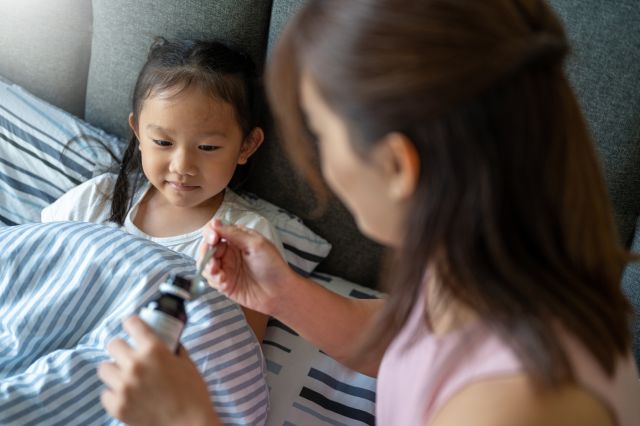Updated on October 20, 2023.
To many of us who grew up taking it, codeine is a familiar drug. But it’s vital to be aware that things have changed. Opioids—including codeine, tramadol, and hydrocodone— are no longer considered safe to give to children in most cases.
No more codeine for kids
Less potent than other opioids, codeine is typically used to treat mild to moderate pain. It’s most commonly found in a number of cough medicines, which a majority of states require a prescription to access.
But opioids, including codeine in rare cases, can contribute to injury or death in children. And over the years, evidence has mounted that codeine is not worth the risk. In 2016, a report published in the journal Pediatrics found the drug contributed to 64 cases of suppressed breathing and two dozen deaths—mostly in kids under 12—between 1965 and 2015. Based on these findings, the American Academy of Pediatrics (AAP) warned against giving the opioid to children.
Then, in 2017, the Food and Drug Administration (FDA) moved to restrict the use of both codeine and tramadol medicines in children. Citing serious risks like breathing difficulties and death, the FDA forbade the use of these drugs in children under 12 and recommended that their use should be limited to older children. The following year, the FDA went one step further and said no one under the age of 18 should use prescription cough or cold medicines that contain codeine or hydrocodone.
In short, opioids pose a danger to children. But other analgesics (pain relievers) are safer options to treat pain.
Non-opioid pain relief options
The American College of Surgeons notes that children may still be prescribed certain opioids for pain relief after major or complex surgeries. But for most cases of pain, the organization recommends non-opioid medications—such as acetaminophen or ibuprofen—combined with therapies that don’t involve medicines.
Always consult a healthcare provider (HCP) before giving any medications or mix of medications to your child. Note also that aspirin should not be administered to children or teenagers with chicken pox or flu-like symptoms. It can increase the risk of Reye’s syndrome, a condition that causes liver damage and swelling of the brain.
Therapies that don’t involve medications may include:
- Physical measures such as massage or heat and cold application
- Exercise including everyday play and movement (unless restricted by an HCP)
- Rehabilitation therapies such as physical or occupational therapy
- Behavioral measures including relaxation techniques, art and play therapy, and biofeedback
- Cognitive measures like psychotherapy and guided imagery
Continuing to providing basic care is important, too. This can include anything enjoyable and distracting like books or games, as well as calming activities like music and a caregiver’s soothing reassurance.
Be safe, be mindful
While acetaminophen and ibuprofen are generally safe for children, it’s important to pay special attention when administering these medications. Simple mistakes or oversights can result in harm. Try these tips for taking care and reducing errors:
- Read all instructions carefully, taking particular note of dosage, medication schedule, whether the drugs should be taken with food or drink, and potential side effects.
- Take your time measuring medicine, as rushing may result in giving more or less than recommended.
- Communicate with other caregivers, so you don’t accidentally administer multiple doses.
- Be sure you’re using the children’s formulation of any given medicine instead of the adult version.
- If there are multiple kids in the home, double-check that you’re administering the correct medication to the right child.
- To keep children from accidentally ingesting drugs, put all medication away in a safe storage area when you’re finished.
Following instructions exactly is key to ensuring medication is effective and safe. If you have any questions about how to treat your child for their pain, consult an HCP.







